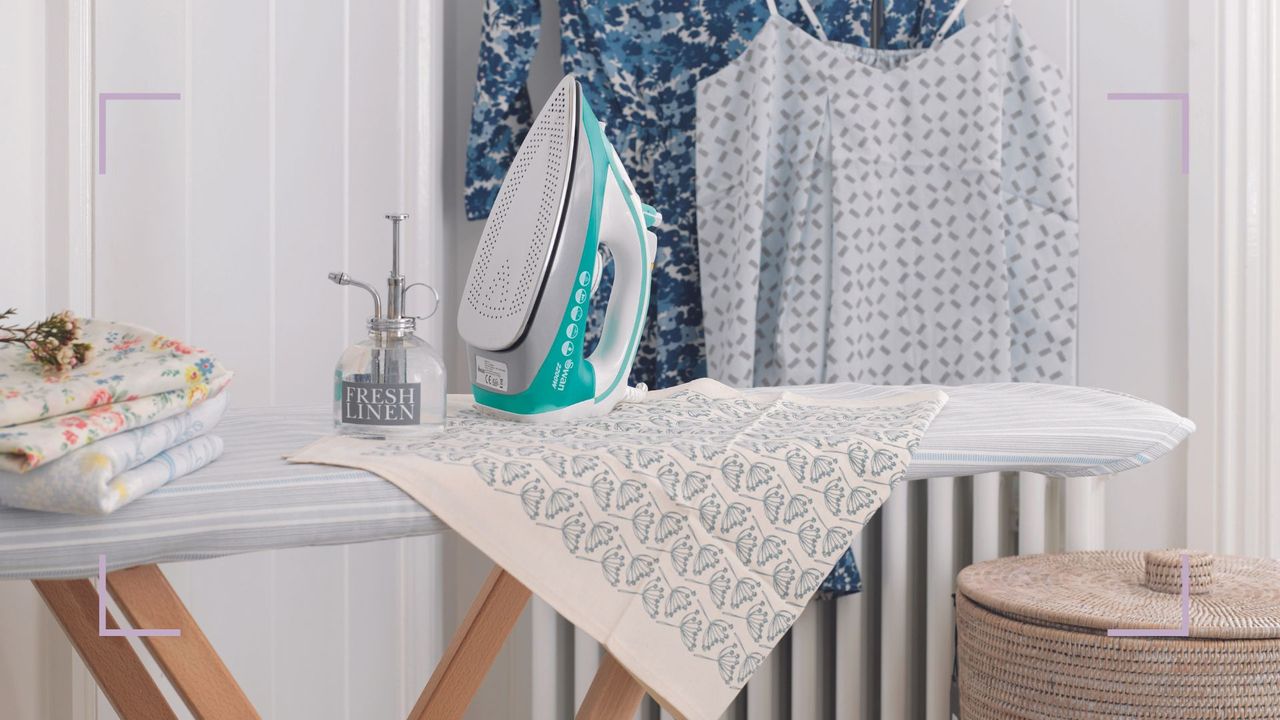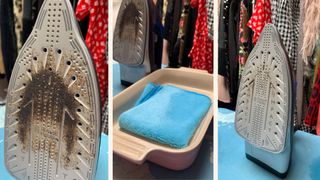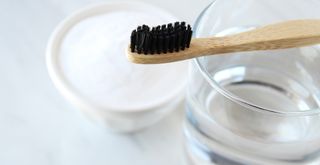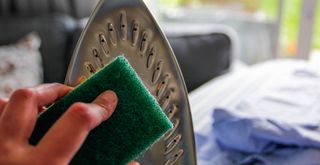How to clean an iron: simple methods to get rid of limescale and burnt-on fibers
Keep your appliance and clothes pristine by following these quick and easy DIY methods using vinegar, baking soda, and more

Knowing how to clean an iron is as essential as owning the home appliance in the first place. Why? Because if your iron's not clean, it's not working at its best, meaning your clothes and linens won't look as smooth, or sharply pressed, as they could.
If your iron hasn't been properly cleaned it may stop working as it should. And, over time, you might see some sticky residue accumulate on your iron, or worse, get transferred onto your freshly laundered clothes. You may also see some stains on the flat, metal soleplate, which can make ironing your clothes much harder, and if not dealt with promptly can even damage the clothes themselves.
But the most frequent issue with irons? They are prone to accumulating limescale, which can stop the steam mechanism of your iron from working properly.
If any of this sounds like something you're experiencing with your appliance, it's time to give your iron a good clean.
Why you should check your iron's instructions first
Before you clean your iron though, check which descaling method is recommended for your specific model. While similar in form and function, irons can differ in their internal mechanisms, which means they may need to be descaled in a very particular way.
The three most common descaling methods are:
- Pressurized steam: In most irons, pressurized steam is blasted out of the vents to remove any dirt or built-up residue.
- Flushing: Some irons can connect easily to your tap, allowing you to flush water through the appliance in order to descale it.
- Chamber: Some irons come with a built-in chamber, which is designed to collect limescale residue over time. In this case, the chamber can be easily removed and cleaned out.
As a first option, try the method in your owner's manual to see if cleans out your iron satisfactorily, resolving any issues you may be having during use. If this doesn't do the job however—for instance on an iron that hasn't been cleaned for some time—you may require a more thorough cleaning technique. Try one of the methods below to get your iron fresh, clean and steaming away creases beautifully again.
Sign up for the woman&home newsletter
Sign up to our free daily email for the latest royal and entertainment news, interesting opinion, expert advice on styling and beauty trends, and no-nonsense guides to the health and wellness questions you want answered.
5 simple steps for cleaning an iron
If your iron's on the blink, don't automatically think it needs replacing because it may well just need a good clean. And you don't even have to purchase a special cleaner to do it; learn how to clean an iron with our five simple steps using dish soap, vinegar, and baking soda.
1. Use a damp cloth with water

"Before you start, make sure the iron is unplugged and completely cool," advises Shirley Langridge, a professional appliance cleaning technician at Fantastic Services. "Besides that, set up a clean and sturdy surface to work on, preferably covered with an old towel or cloth to protect it from any potential residue or stains."
You will also need to get a cleaning tool ready to do the job with ease. For this you will need:
- A clean microfibre cloth
- Dish soap
- Salt
- Distilled white vinegar
- Soft sponge
- Baking soda (optional)
2. Clean the exterior
It's amazing how much dust an iron can collect, particularly around the handle. Take a dry cleaning cloth to pre-wipe over the surface to remove the initial dust. After this Shirley advises: "Use a damp cloth or sponge to wipe the exterior of the iron. For tougher stains, use mild dish soap."
"When cleaning the exterior, avoid using abrasive cleaners or scrub brushes, because they may damage the iron's surface," warns Shirley.
3. Clean the soleplate (bottom on the iron)

The plate will be the dirtiest part of most irons. Depending on the severity of the grime or burnt patches cleaning may vary. Shirley also warns: "Before you start, check the manufacturer's instructions to determine if your iron has a non-stick coating. If it does, make sure you’re working very carefully to avoid scratching it."
Generally speaking you start by using a soft, moist cloth to wipe down the surface of the cooled plate. If the water on the cloth doesn't seem to be doing the trick to lift stains or remove sticky surfaces, you may want to add a gentle detergent, such as dish detergent. You can also use a soft sponge to add a bit more resistance.
"For regular maintenance, sprinkle a small amount of table salt on a piece of plain paper and set the iron to the lowest heat setting," advises Shirley. "Gently glide the iron over it, making sure the soleplate comes into contact with the salt. This will help remove built-up residue or fabric stains. Once you’re finished, wipe the soleplate with a clean, damp cloth to remove any remaining salt or debris."
4. Tackle stubborn stains

If your iron has a significant buildup of burnt-on residue you may need to resort to strong measures. "If you notice stubborn stains or mineral deposits on the soleplate, use a mixture of equal parts distilled white vinegar and water," Shirley suggests.
Vinegar is a versatile store-cupboard ingredient: you can also use it to learn how to descale a kettle. But before employing this method, make sure you consult your iron's manual first; some types of irons don't take kindly to vinegar.
If you're good to go: "Dampen a cloth with the solution and rub the problem areas of the soleplate." We tried this method and it really does work, but we'd suggest using circular rubbing motions using the soft sponge to get a bit more friction to remove the burnt-on patches. To clean around the spray nozzle and water tank to remove any traces of limescale you can use a soft bristle toothbrush to work the vinegar solution into the grooves and gaps.
This method of cleaning with vinegar should remove almost all levels of grime left on a soleplate but Shirley does have another trick up her sleeve, just in case.
"For even more stubborn stains, use a paste made from baking soda and water. Apply it to the stains, let it sit for a few minutes and gently scrub with a soft cloth or sponge."
After you’ve finished cleaning by any of these methods it's key to wipe the soleplate with a damp cloth to remove any residue from the vinegar or baking soda – because the last thing you want is for your fresh laundry to smell of vinegar.
5. Steam the vents to remove limescale
Whenever there's stagnant water you are likely to suffer from limescale, the inside of the iron is no exception. An easy way to tackle the problem is with a quick steam clean.
"To clean the steam vents, fill the iron's water reservoir with equal parts water and white vinegar,' advises Shirley. "Set the iron to a medium heat setting and allow it to steam for a few minutes, directing the steam away from yourself and any sensitive surfaces."
"This process will help remove mineral deposits and unclog the vents. Once you’re finished, empty the reservoir, refill it with clean water, and run the iron on a clean cloth or towel to flush out any remaining vinegar solution." Again, this prevents the scent of vinegar from being transferred onto your freshly laundered clothes.
What is the best way to clean a burnt iron?
Baking soda can work all kinds of miracles when it comes to household cleaning. In this instance, mix together baking soda and water to form a paste to clean a burnt iron.
“Tough brown marks found on your iron can be stubborn to remove, however by mixing two tablespoons of baking soda and one tablespoon of water into a paste you have a cleaner that is sure to banish away those stains," says Nick Small, small appliances expert at AO.com.
After making sure the iron is completely cool, wipe the mixture onto the soleplate. "Simply rub the mixture around the soleplate of the iron, making sure to avoid the steam holes," advises Nick. Leave the paste to sit for a few minutes, then wipe it off gently with a damp cloth and It should look as good as new.
Note: baking soda is also a fabulously helpful tool for learning how to clean a stovetop, how to clean garbage disposal units, how to clean aluminum, and how to clean walls, too.

How do you clean the reservoir of an iron?
To effectively clean the reservoir of your iron to maintain its performance and prevent mineral buildup, experts recommend using a cleaning solution made of equal parts distilled white vinegar and water.
"Make sure that the appliance is unplugged and completely cooled down before starting and set up a clean working surface to work on covered with an old towel or cloth to protect it," Shirley advises. "If there is any water remaining in the reservoir, carefully pour it out into the sink, being careful not to spill water on the iron or any of its electrical components."
"Prepare the cleaning solution and fill the reservoir about halfway up. Allow it to sit in the reservoir for at least 30 minutes to break down mineral deposits and loosen any buildup. Using a soft brush or a cloth, gently scrub the inside of the reservoir to remove any remaining deposits or residue. Pay extra attention to any corners or crevices where buildup may have accumulated. Afterward, thoroughly rinse the reservoir with clean water. Fill it with water and empty it a few times to flush out any remaining residue."
After cleaning and rinsing the reservoir it's recommended to leave it open or upside down to air dry completely – making sure no moisture is left inside.

What should you never do when cleaning an iron?
When cleaning an iron there are certain materials and cleaners that are not recommended but also practices that should be avoided to ensure a safe clean each time.
- Never submerge an iron in water: As an electrical appliance, even when it's turned off you should never submerge it in water because it can cause serious damage or electrical hazards when you do plug it back in.
- Never clean an iron while it's hot: "Never clean the iron while it's still hot or plugged in," warns Shirley. "Always ensure that the iron is completely cooled down and unplugged before cleaning. Cleaning a hot appliance can result in burns or damage to both the iron and the cleaning materials." You run the risk of cleaning tool melting onto the surface of the plates.
- Avoid using abrasive materials or harsh chemicals: "Avoid using abrasive cleaners, scouring pads, rough materials that can scratch or damage the surface of the iron," advises Shirley. "Bleach, ammonia, or strong solvents because they can corrode or discolor the iron's components."
- Never pour cleaning solutions directly onto the iron: "Instead, apply cleaning solutions or substances to a cloth or sponge and then use them to clean the iron," advises Shirley. "Pouring solutions directly onto the iron can lead to liquid entering the iron's interior, causing damage or electrical issues."
How often should you descale your iron?
Know we know how to clean an iron, how often should we actually be doing it? Most irons need descaling every one to three months, but, like when asking how often to descale a kettle specific timing does depend on the model and manufacturer; check your manual to see if a recommended schedule is provided.
If you're not able to locate this information, aim for every two months, especially if you use the iron often. Some irons may stop working if they haven't been cleaned for a while, so make sure you keep an eye on limescale build-up to prevent unexpected hiccups – especially if you tend to iron and go at the start of the day.
As a general rule, the longer you leave limescale to build up the harder it is to clean. The same applies to other household appliances—so perhaps it will pay off to learn how to clean a showerhead, how to clean a dishwasher, or how to clean a stainless steel sink, too to stay on top of limescale buildups.
Doing routine maintenance of your home's kitchen gadgets and appliances may not be the most exciting thing on your to-do list, but it will save you tons of time and stress. Set yourself a regular reminder, and make ironing your easiest chore.
Amy Hunt is an experienced digital journalist specialising in homes, interiors and hobbies. She began her career working as the features assistant at woman&home magazine, before moving over to the digital side of the brand where she eventually became the Lifestyle Editor up until January 2022. Amy won the Digital Journalist of the Year award at the AOP Awards in 2019 for her work on womanandhome.com.
- Tamara KellyLifestyle Editor
